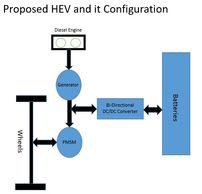The HEV Project
Electric Vehicle-Then
Representation of an ICE and its efficiency
Electric Vehicle-Then

Around 1832, Robert Anderson develops the first crude electric vehicle, but it isn't until the 1870s or later that electric cars become practical.
Electric Vehicle-Now
Representation of an ICE and its efficiency
Electric Vehicle-Then

A basic layout of the different components of an Electric cars of today. Each company has its own configurations.
Representation of an ICE and its efficiency
Representation of an ICE and its efficiency
Representation of an ICE and its efficiency

As you can see, the Internal combustion engine (ICE) is only 33% efficient
An EV and its configuration
An EV and its configuration
Representation of an ICE and its efficiency

The Electric Vehicle Design has an efficiency of 89% as compared to the ICE's 33%
The Dream Wheel
An EV and its configuration
An EV with Dream Wheels

An idea to just replace the present wheels with a complete integrated drive system. Very efficient and the conversion is quite easy.
An EV with Dream Wheels
An EV and its configuration
An EV with Dream Wheels

An EV with Dream Wheels, just replace each wheels with the new Dream Wheels, add the batteries and the wiring and Voila!
Configuration and Operational Modes of the HEV
Configuration
Battery Drive Mode
Configuration

The Proposed HEV consists of the wheels, a PMSM linear motor with controller, a Bi-Directional DC/DC converter, The Batteries, a Generator that is driven by a two cylinders Diesel engine for extended driving distances.
Charging Mode
Battery Drive Mode
Configuration

In the Charging Mode, the Internal Combustion Engine (ICE) would be running the Generator whose output is passed thru a Field Oriented Converter (FOC) then thru the Bi-Directional DC/DC controller to charge the batteries as necessary.
Battery Drive Mode
Battery Drive Mode
Battery Drive Mode

In the Battery-Drive Mode, The car is already in motion and all the drive energy to the traction motor (PMSM) is derived solely from the batteries. Not shown, but the Drive Traction has a Field Oriented Controller that takes the DC power and generate the necessary three phase to power it properly.
Full Drive Mode
Extended Drive Mode
Battery Drive Mode

In the Full-Drive Mode, the Drive energy comes from the Batteries as well as the ICE driven Generator. Note there are no mechanical linkages between the drive train and the ICE. Here again, the output of the Generator passes thru a FOC controller that condition its 3 phase outputs into a DC to supplement the needed energy to the Drive Traction Motor directly.
Extended Drive Mode
Extended Drive Mode
Extended Drive Mode

In the Extended drive-Mode, again all the energy needed by the traction PMSM motor is derived from the Batteries. This mode differs slightly from the Full drive Mode in that in that the energy generated by the Generator can also be diverted to charge the Batteries. In this mode, one can rest assured knowing that as long there is fuel in the tank, the car will continue to move to its final destination
Regenerative Mode
Extended Drive Mode
Extended Drive Mode

In the Regenerative Mode and also known as dynamic braking, the kinetic energy is transformed by the traction PMSM motor to electrical energy. This energy is further conditioned by the same Drive Inverter (FOC Inverter) to DC which in turn is fed to the DC/DC converter to charge the Batteries.
This website uses cookies.
We use cookies to analyze website traffic and optimize your website experience. By accepting our use of cookies, your data will be aggregated with all other user data.